MSDS危险化学品安全技术说明书——61904--一氯杀螨砜、杀螨砜、氯苯砜
- 格式:docx
- 大小:42.50 KB
- 文档页数:6
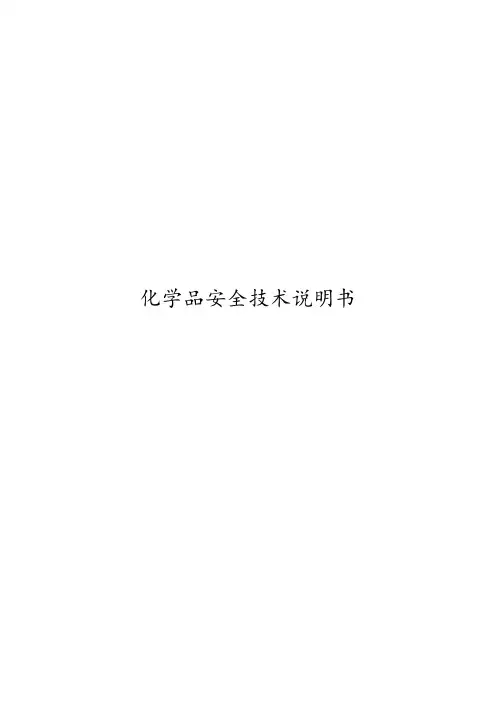
化学品安全技术说明书二〇〇六年二月目录表1-001 乙炔气 (1)表1-002 氧气 (5)表1-003 二氧化碳 (11)表1-004 氢气 (13)表1-005 氩气 (15)表1-006 甲烷 (17)表1-007 四氢噻吩 (19)表1-008 活性炭 (21)表1-009 三乙胺 (23)表1-010 硫代磷酰氯 (25)表1-011 硫黄 (27)表1-012 甲胺磷 (30)表1-013 多聚甲醛 (32)表1-014(附表1-3)甲缩醛34 表1-015 黄磷 (36)表1-016 氯 (38)表1-017 三氯化磷 (41)表1-018 甲醇 (45)表1-019 液碱 (47)表1-020 氨水 (49)表1-021 硫酸二甲酯 (52)表1-022 甲胺磷 (54)表1-023 液氨 (57)表1-024 氯仿 (59)表1-025 二氯乙烷 (61)表1-026 二硫化碳 (64)表1-027 甲苯 (66)表1-028 盐酸 (68)表1-029 氯甲烷 (71)表1-030 硫酸 (73)表1-031 二甲苯 (76)表1-032 醋酸酐 (78)表1-033 多聚甲醛 (81)表1-034 草甘膦 (82)表1-035 稻瘟灵 (84)表1-036 异丙胺 (86)表1-037 漂白粉 (88)表1-038 氯化氢 (90)表1-039 氰化氢 (93)表1-040 氰化钠 (95)表1-041 氯乙酸 (97)表1-042 甲缩醛 (99)表1-043 丙烯腈 (102)表1-044 氧化亚铜 (104)表1-045 四氯化锡 (106)表1-046 四氧化三铅 (108)表1-047 三氯化铝(无水) 111 表1-048 松香水 (113)表1-049红丹油性防锈漆 .. 114 表1-050 酚醛树脂 (116)表1-051 硫磺粉(补充) (117)表1-052 一乙胺 (119)表1-053三聚氯氰 (121)表1-054 三氯乙烯 (123)表1-055 磷酸 (125)表1-056 四丁基锡 (127)表1-057 柴油 (129)表1-058 对氨基苯酚 (131)表1-059 醋酸乙酯 (133)表1-060 对氯硝基苯 (135)表1-061 氮气 (136)表1-062莠去津 (140)表1-063 扑草净 (141)表1-064 八氯二丙醚 (143)表1-065 硫化钠 (145)表1-066 异丙醇 (148)表1-067 丙酮 (150)表1-068 二氯丙烷 (152)表1-069 环己酮 (154)表1-070 乙酸异戊酯 (156)表1-071 锌粉 (158)表1-072 乙醇 (160)表1-073 次氯酸钠溶液 (163)表1-074 石脑油 (164)表1-075 双环戊二烯 (167)表1-076 乙酸丁酯 (168)表1-077 双氧水 (170)表1-078 丙烯酸丁酯 (173)表1-079 丙烯酸 (175)表1-080 苯乙烯 (177)表1-081 过硫酸铵 (179)表1-082 过硫酸钾 (181)表1-083 丙烯酰胺 (183)表1-084 甲醛 (185)表1-085 甲基丙烯酸甲酯.. 187 表1-086 甲基丙烯酸 (189)表1-087 汽油 (192)表1-088 乙酸 (194)表1-089 丙烯酸树脂 (196)表1-090 丙烯酸清漆 (198)表1-091 丙烯酸漆稀释剂.. 199 表1-092 丙烯酸磁漆 (201)表1-093 二乙醇胺 (203)表1-094 煤油 (205)表1-095 漂白粉 (206)表1-096 漂粉精 (208)表1-097 三氯异氰尿酸 (210)表1-098 松香 (212)表1-099 松节油 (213)表1-100 硫化钠 (215)表1-101 保险粉 (217)表1-102 7385聚氨酯清漆(分装) (219)表1-103 甲酸 (221)表1-104 乙酸乙二醇乙醚.. 223 表1-105 H-3聚氨酯漆固化剂 (225)表1-106 聚氨酯漆稀释剂.. 226 表1-107 263醇酸树脂 (228)表1-108 异噻唑啉酮 (229)表1-109 N-乙基苯胺 (231)表1-110苯胺 (233)表1-111 乙酰甲胺磷 (235)表1-112 亚磷酸 (237)表1-113 亚磷酸二甲酯 (239)表1-114 氯甲烷 (242)表1-115 乙醚 (244)表1-116 丙烯酸甲酯 (246)表1-117 一甲胺 (248)表1-118 硝酸镁 (250)表1-119 硫化氢 (252)表1-120 硫化铵 (254)表1-121 一甲胺水溶液 (256)表1-122 兔宝宝面漆 (257)表1-123 兔宝宝稀释剂 (259)表1-124 硫氢化钠 (261)表1-125丙酸 (262)表1-126乙酰氯 (264)表1-127丙酰氯 (266)表1-128 丁醇 (268)表1-129 醇酸调合漆(未列名) (270)表1-129 碳化钙、电石 (272)表1-130 硝酸钠 (273)表1-131 溴甲烷 (275)表1-132 磷化铝 (278)表1-133 正丁醇 (280)表1-134 硝基木器漆 (282)表1-135 硝化棉(含氮≤12.6%) (283)表1-136 单丁醚 (285)表1-137 砷 (287)表1-138 碘化汞 (289)表1-139 氯化汞 (291)表1-140 叠氮化钠 (293)表1-141 重铬酸钠 (294)表1-142 高锰酸钾 (296)表1-143 氰化金钾 (299)表1-144丙烯酸 (301)表1-145甲基丙烯酸甲酯 .. 303 表1-146苯乙烯 (305)表1-147丙烯酸丁酯 (307)表1-148丁醇 (309)表1-149偶氮二异丁腈 (311)表1-150甲基丙烯酸异丁酯313 表1-151 甲基丙烯酸(正)丁酯 (315)表1-152 乙酰丙酮 (316)表1-153 2-丁酮 (318)表1-154 生松香 (320)表1-155 硫酸铜 (322)表1-155 硝酸 (324)表1-155 氰化钾 (326)表1-156硝基苯 (328)表1-157 氟化钠 (330)表1-158 氢氟酸 (332)表1-159蓄电池(注有酸液) (334)表1-160 环氧树脂 (335)表1-161 氯苯 (337)表1-162 乙苯 (340)表1-163 樟脑 (342)表1-164 赛璐珞 (344)表1-165 氢氧化钾 (345)表1-166 乙酸丁酯 (347)表1-001 乙炔气表1-002 氧气表1-003 二氧化碳表1-004 氢气表1-005 氩气表1-006 甲烷表1-007 四氢噻吩表1-008 活性炭活性炭 C 12.0Active carbon别名:Activated chlarcoal危规分类及编号:自燃物品。
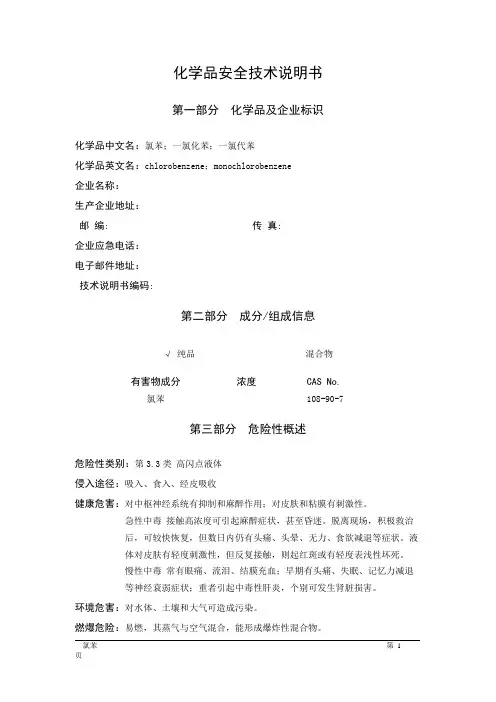
化学品安全技术说明书第一部分化学品及企业标识化学品中文名:氯苯;一氯化苯;一氯代苯化学品英文名:chlorobenzene;monochlorobenzene企业名称:生产企业地址:邮编: 传真:企业应急电话:电子邮件地址:技术说明书编码:第二部分成分/组成信息√纯品混合物有害物成分浓度CAS No.氯苯108-90-7第三部分危险性概述危险性类别:第3.3类高闪点液体侵入途径:吸入、食入、经皮吸收健康危害:对中枢神经系统有抑制和麻醉作用;对皮肤和粘膜有刺激性。
急性中毒接触高浓度可引起麻醉症状,甚至昏迷。
脱离现场,积极救治后,可较快恢复,但数日内仍有头痛、头晕、无力、食欲减退等症状。
液体对皮肤有轻度刺激性,但反复接触,则起红斑或有轻度表浅性坏死。
慢性中毒常有眼痛、流泪、结膜充血;早期有头痛、失眠、记忆力减退等神经衰弱症状;重者引起中毒性肝炎,个别可发生肾脏损害。
环境危害:对水体、土壤和大气可造成污染。
燃爆危险:易燃,其蒸气与空气混合,能形成爆炸性混合物。
第四部分急救措施皮肤接触:脱去污染的衣着,用肥皂水和清水彻底冲洗皮肤。
如有不适感,就医。
眼睛接触:提起眼睑,用流动清水或生理盐水冲洗。
如有不适感,就医。
吸入:迅速脱离现场至空气新鲜处。
保持呼吸道通畅。
如呼吸困难,给输氧。
呼吸、心跳停止,立即进行心肺复苏术。
就医。
食入:饮水,禁止催吐。
如有不适感,就医。
第五部分消防措施危险特性:易燃,遇明火、高热或与氧化剂接触,有引起燃烧爆炸的危险。
与过氯酸银、二甲亚砜反应剧烈。
有害燃烧产物:一氧化碳、氯化物。
灭火方法:用雾状水、泡沫、干粉、二氧化碳、砂土灭火。
灭火注意事项及措施:消防人员必须佩戴空气呼吸器、穿全身防火防毒服,在上风向灭火。
喷水冷却容器,可能的话将容器从火场移至空旷处。
处在火场中的容器若已变色或从安全泄压装置中产生声音,必须马上撤离。
第六部分泄漏应急处理应急行动:消除所有点火源。
根据液体流动和蒸气扩散的影响区域划定警戒区,无关人员从侧风、上风向撤离至安全区。
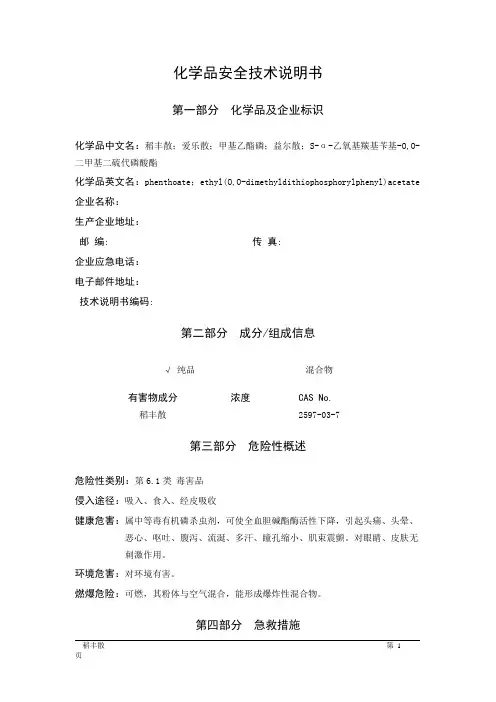
化学品安全技术说明书第一部分化学品及企业标识化学品中文名:稻丰散;爱乐散;甲基乙酯磷;益尔散;S-α-乙氧基羰基苄基-O,O-二甲基二硫代磷酸酯化学品英文名:phenthoate;ethyl(O,O-dimethyldithiophosphorylphenyl)acetate 企业名称:生产企业地址:邮编: 传真:企业应急电话:电子邮件地址:技术说明书编码:第二部分成分/组成信息√纯品混合物有害物成分浓度CAS No.稻丰散2597-03-7第三部分危险性概述危险性类别:第6.1类毒害品侵入途径:吸入、食入、经皮吸收健康危害:属中等毒有机磷杀虫剂,可使全血胆碱酯酶活性下降,引起头痛、头晕、恶心、呕吐、腹泻、流涎、多汗、瞳孔缩小、肌束震颤。
对眼睛、皮肤无刺激作用。
环境危害:对环境有害。
燃爆危险:可燃,其粉体与空气混合,能形成爆炸性混合物。
第四部分急救措施皮肤接触:立即脱去污染的衣着,用肥皂水及流动清水彻底冲洗污染的皮肤、头发、指甲等。
如有不适感,就医。
眼睛接触:提起眼睑,用流动清水或生理盐水冲洗。
如有不适感,就医。
吸入:迅速脱离现场至空气新鲜处。
保持呼吸道通畅。
如呼吸困难,给输氧。
呼吸、心跳停止,立即进行心肺复苏术。
就医。
食入:饮足量温水,催吐。
用1:5000高锰酸钾溶液洗胃。
口服活性碳,导泻。
每5分钟给服一片阿托品,直到感觉口干为止。
就医。
第五部分消防措施危险特性:遇明火、高热可燃。
其粉体与空气可形成爆炸性混合物, 当达到一定浓度时, 遇火星会发生爆炸。
受高热分解放出有毒的气体。
有害燃烧产物:一氧化碳、氧化硫、氧化磷。
灭火方法:用雾状水、泡沫、干粉、二氧化碳、砂土灭火。
灭火注意事项及措施:消防人员须佩戴防毒面具、穿全身消防服,在上风向灭火。
尽可能将容器从火场移至空旷处。
喷水保持火场容器冷却,直至灭火结束。
第六部分泄漏应急处理应急行动:隔离泄漏污染区,限制出入。
建议应急处理人员戴防尘口罩,穿防毒服。
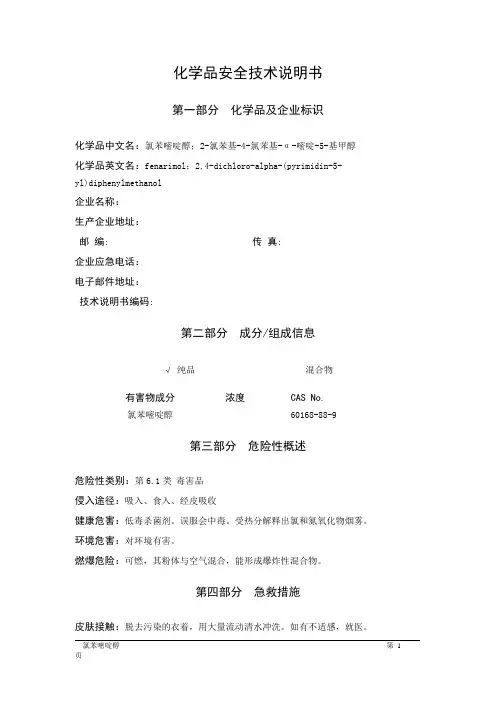
化学品安全技术说明书第一部分化学品及企业标识化学品中文名:氯苯嘧啶醇;2-氯苯基-4-氯苯基-α-嘧啶-5-基甲醇化学品英文名:fenarimol;2,4-dichloro-alpha-(pyrimidin-5-yl)diphenylmethanol企业名称:生产企业地址:邮编: 传真:企业应急电话:电子邮件地址:技术说明书编码:第二部分成分/组成信息√纯品混合物有害物成分浓度CAS No.氯苯嘧啶醇60168-88-9第三部分危险性概述危险性类别:第6.1类毒害品侵入途径:吸入、食入、经皮吸收健康危害:低毒杀菌剂。
误服会中毒。
受热分解释出氯和氮氧化物烟雾。
环境危害:对环境有害。
燃爆危险:可燃,其粉体与空气混合,能形成爆炸性混合物。
第四部分急救措施皮肤接触:脱去污染的衣着,用大量流动清水冲洗。
如有不适感,就医。
眼睛接触:提起眼睑,用流动清水或生理盐水冲洗。
如有不适感,就医。
吸入:迅速脱离现场至空气新鲜处。
保持呼吸道通畅。
如呼吸困难,给输氧。
呼吸、心跳停止,立即进行心肺复苏术。
就医。
食入:饮足量温水,催吐、洗胃、导泻。
就医。
第五部分消防措施危险特性:遇明火、高热可燃。
其粉体与空气可形成爆炸性混合物, 当达到一定浓度时, 遇火星会发生爆炸。
受高热分解放出有毒的气体。
有害燃烧产物:一氧化碳、氮氧化物、氯化氢。
灭火方法:用雾状水、泡沫、干粉、二氧化碳、砂土灭火。
灭火注意事项及措施:消防人员必须佩戴空气呼吸器、穿全身防火防毒服,在上风向灭火。
尽可能将容器从火场移至空旷处。
喷水保持火场容器冷却,直至灭火结束。
第六部分泄漏应急处理应急行动:隔离泄漏污染区,限制出入。
建议应急处理人员戴防尘口罩,穿一般作业工作服。
尽可能切断泄漏源。
用塑料布覆盖泄漏物,减少飞散。
勿使水进入包装容器内。
用洁净的铲子收集泄漏物,置于干净、干燥、盖子较松的容器中,将容器移离泄漏区。
第七部分操作处置与储存操作注意事项:密闭操作,局部排风。
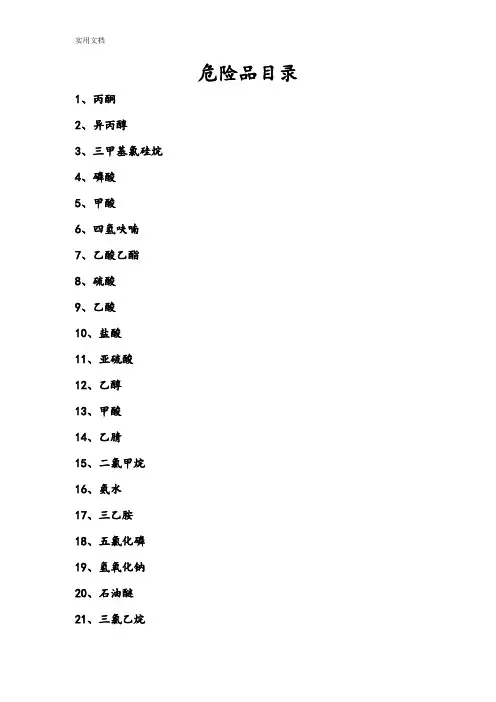
危险品目录
1、丙酮
2、异丙醇
3、三甲基氯硅烷
4、磷酸
5、甲酸
6、四氢呋喃
7、乙酸乙酯
8、硫酸
9、乙酸
10、盐酸
11、亚硫酸
12、乙醇
13、甲酸
14、乙腈
15、二氯甲烷
16、氨水
17、三乙胺
18、五氯化磷
19、氢氧化钠
20、石油醚
21、三氯乙烷
22、吡啶
23、六甲基二硅烷
24、正已烷
25、液氨
26、三氧甲烷
27、醋酸酐
1.4主要原辅料-危险化学品安全技术说明书(MSDS):
表1.4-1 丙酮
表1.4-2异丙醇
表1.4-3三甲基氯硅烷
表1.4-4磷酸
表1.4-5甲酸
表1.4-6四氢呋喃
表1.4-7乙酸乙酯
表1.4-8硫酸
表1.4-9乙酸
表1.4-10盐酸
表1.4-11亚硫酸
表1.4-12乙醇
表1.4-13甲醇
表1.4-14乙腈
表1.4-15二氯甲烷
表1.4-16氨水
表1.4-17三乙胺
表1.4-18五氯化磷
表1.4-19氢氧化钠
表1.4-20石油醚
表1.4-21三氯乙烷
表1.4-22吡啶
表1.4-23六甲基二硅烷
表1.4-24正己烷。
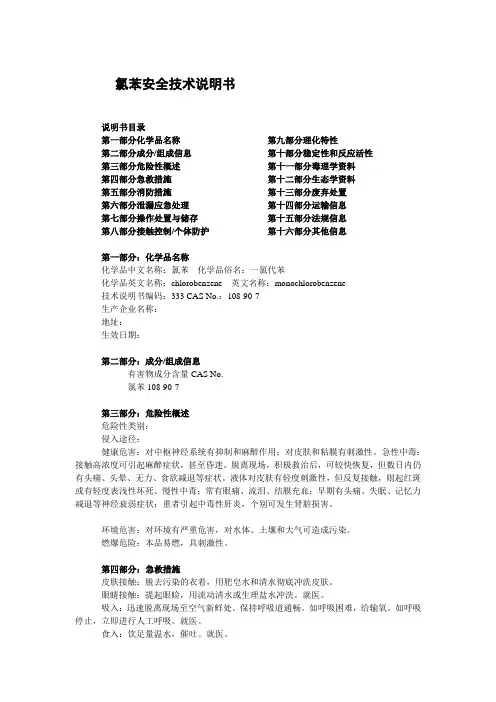
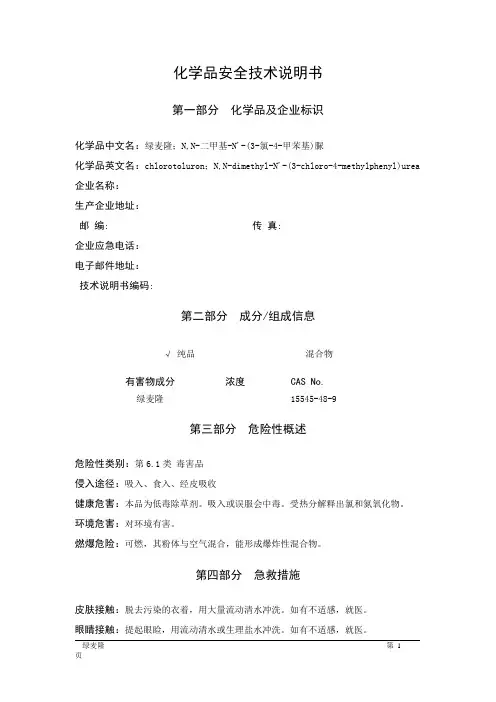
化学品安全技术说明书第一部分化学品及企业标识化学品中文名:绿麦隆;N,N-二甲基-N'-(3-氯-4-甲苯基)脲化学品英文名:chlorotoluron;N,N-dimethyl-N'-(3-chloro-4-methylphenyl)urea 企业名称:生产企业地址:邮编: 传真:企业应急电话:电子邮件地址:技术说明书编码:第二部分成分/组成信息√纯品混合物有害物成分浓度CAS No.绿麦隆15545-48-9第三部分危险性概述危险性类别:第6.1类毒害品侵入途径:吸入、食入、经皮吸收健康危害:本品为低毒除草剂。
吸入或误服会中毒。
受热分解释出氯和氮氧化物。
环境危害:对环境有害。
燃爆危险:可燃,其粉体与空气混合,能形成爆炸性混合物。
第四部分急救措施皮肤接触:脱去污染的衣着,用大量流动清水冲洗。
如有不适感,就医。
眼睛接触:提起眼睑,用流动清水或生理盐水冲洗。
如有不适感,就医。
吸入:迅速脱离现场至空气新鲜处。
保持呼吸道通畅。
如呼吸困难,给输氧。
呼吸、心跳停止,立即进行心肺复苏术。
就医。
食入:饮足量温水,催吐、洗胃、导泻。
就医。
第五部分消防措施危险特性:遇明火、高热可燃。
其粉体与空气可形成爆炸性混合物, 当达到一定浓度时, 遇火星会发生爆炸。
遇高热分解释出高毒烟气。
有害燃烧产物:一氧化碳、氮氧化物、氯化氢。
灭火方法:用雾状水、泡沫、干粉、二氧化碳、砂土灭火。
灭火注意事项及措施:消防人员必须佩戴空气呼吸器、穿全身防火防毒服,在上风向灭火。
尽可能将容器从火场移至空旷处。
喷水保持火场容器冷却,直至灭火结束。
第六部分泄漏应急处理应急行动:隔离泄漏污染区,限制出入。
建议应急处理人员戴防尘口罩,穿一般作业工作服。
尽可能切断泄漏源。
用塑料布覆盖泄漏物,减少飞散。
勿使水进入包装容器内。
用洁净的铲子收集泄漏物,置于干净、干燥、盖子较松的容器中,将容器移离泄漏区。
第七部分操作处置与储存操作注意事项:密闭操作,局部排风。
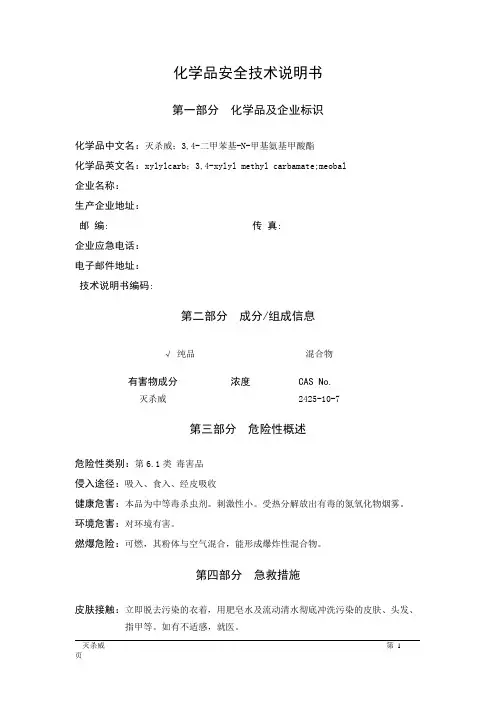
化学品安全技术说明书第一部分化学品及企业标识化学品中文名:灭杀威;3,4-二甲苯基-N-甲基氨基甲酸酯化学品英文名:xylylcarb;3,4-xylyl methyl carbamate;meobal企业名称:生产企业地址:邮编: 传真:企业应急电话:电子邮件地址:技术说明书编码:第二部分成分/组成信息√纯品混合物有害物成分浓度CAS No.灭杀威2425-10-7第三部分危险性概述危险性类别:第6.1类毒害品侵入途径:吸入、食入、经皮吸收健康危害:本品为中等毒杀虫剂。
刺激性小。
受热分解放出有毒的氮氧化物烟雾。
环境危害:对环境有害。
燃爆危险:可燃,其粉体与空气混合,能形成爆炸性混合物。
第四部分急救措施皮肤接触:立即脱去污染的衣着,用肥皂水及流动清水彻底冲洗污染的皮肤、头发、指甲等。
如有不适感,就医。
眼睛接触:提起眼睑,用流动清水或生理盐水冲洗。
如有不适感,就医。
吸入:迅速脱离现场至空气新鲜处。
保持呼吸道通畅。
如呼吸困难,给输氧。
呼吸、心跳停止,立即进行心肺复苏术。
就医。
食入:饮足量温水,催吐。
用1:5000高锰酸钾溶液洗胃。
口服活性碳,导泻。
每5分钟给服一片阿托品,直到感觉口干为止。
就医。
第五部分消防措施危险特性:遇明火、高热可燃。
其粉体与空气可形成爆炸性混合物, 当达到一定浓度时, 遇火星会发生爆炸。
受高热分解放出有毒的气体。
有害燃烧产物:一氧化碳、氮氧化物。
灭火方法:用雾状水、泡沫、干粉、二氧化碳、砂土灭火。
灭火注意事项及措施:消防人员须佩戴防毒面具、穿全身消防服,在上风向灭火。
尽可能将容器从火场移至空旷处。
喷水保持火场容器冷却,直至灭火结束。
第六部分泄漏应急处理应急行动:隔离泄漏污染区,限制出入。
建议应急处理人员戴防尘口罩,穿防毒服。
穿上适当的防护服前严禁接触破裂的容器和泄漏物。
尽可能切断泄漏源。
用塑料布覆盖泄漏物,减少飞散。
勿使水进入包装容器内。
用洁净的铲子收集泄漏物,置于干净、干燥、盖子较松的容器中,将容器移离泄漏区。
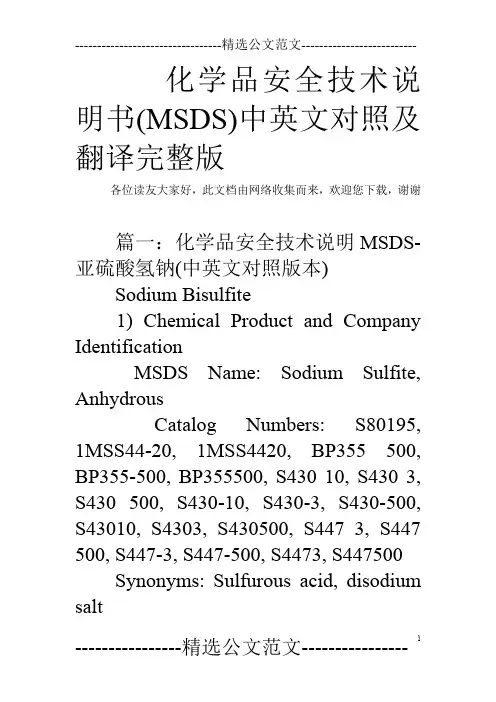
化学品安全技术说明书(MSDS)中英文对照及翻译完整版各位读友大家好,此文档由网络收集而来,欢迎您下载,谢谢篇一:化学品安全技术说明MSDS-亚硫酸氢钠(中英文对照版本)Sodium Bisulfite1) Chemical Product and Company IdentificationMSDS Name: Sodium Sulfite, AnhydrousCatalog Numbers: S80195, 1MSS44-20, 1MSS4420, BP355 500, BP355-500, BP355500, S430 10, S430 3, S430 500, S430-10, S430-3, S430-500, S43010, S4303, S430500, S447 3, S447 500, S447-3, S447-500, S4473, S447500 Synonyms: Sulfurous acid, disodium saltRisk Phrases: 22 36/37/383) Hazards IdentificationEMERGENCY OVERVIEWAppearance: white. Air sensitive. Moisture sensitive. Warning! Causes eye and skin irritation. May cause digestive tract irritation. Causes respiratory tract irritation. May be harmful if swallowed.Target Organs: Central nervous system.Potential Health EffectsEye: Causes eye irritation. May cause chemical conjunctivitis.Skin: Causes skin irritation.Ingestion: May cause gastrointestinal irritation with nausea, vomiting and diarrhea. May be harmful if swallowed.Inhalation: Causes respiratory tract irritation. Can produce delayed pulmonary edema.Chronic: Effects may be delayed.4) First Aid MeasuresEyes: Flush eyes with plenty of water for at least 15 minutes, occasionally lifting the upper and lower eyelids. Get medical aid.Skin: Get medical aid. Flush skin with plenty of soap and water for at least 15 minutes while removing contaminated clothing and shoes. Wash clothing before reuse.Ingestion: If victim is conscious and alert, give 2-4 cupfuls of milk or water. Never give anything by mouth to an unconscious person. Get medical aid immediately.Inhalation: Remove from exposure to fresh air immediately. If not breathing, give artificial respiration. If breathing is difficult, give oxygen. Get medical aid. Notes to Physician: Treat symptomatically and supportively.5) Fire Fighting MeasuresGeneral Information: As in any fire,wear a self-contained breathing apparatus in pressure-demand, MSHA/NIOSH (approved or equivalent), and full protective gear. During a fire, irritating and highly toxic gases may be generated by thermal decomposition or combustion. Wear appropriate protective clothing to prevent contact with skin and eyes. Wear a self-contained breathing apparatus (SCBA) to prevent contact with thermal decomposition products.Extinguishing Media: Substance is noncombustible; use agent most appropriate to extinguish surrounding fire. Do NOT get water inside containers. Use water spray, dry chemical, carbon dioxide, or appropriate foam.6) Accidental Release MeasuresGeneral Information: Use proper personal protective equipment as indicated in Section 8.Spills/Leaks: Vacuum or sweep upmaterial and place into a suitable disposal container. Clean up spills immediately, observing precautions in the Protective Equipment section. Avoid generating dusty conditions. Provide ventilation. Place under an inert atmosphere. Do not get water inside containers.7) Handling and StorageHandling: Wash thoroughly after handling. Use with adequate ventilation. Minimize dust generation and accumulation. Avoid contact with eyes, skin, and clothing. Keep container tightly closed. Avoid ingestion and inhalation. Handle under an inert atmosphere. Store protected from air. Do not allow contact with water. Wash clothing before reuse. Keep from contact with moist air and steam.Storage: Store in a tightly closed container. Keep from contact with oxidizing materials. Store in a cool, dry,well-ventilated area away from incompatible substances. Keep away from strong acids. Do not expose to air. Store protected from moisture. Store under an inert atmosphere.8) Exposure Controls, Personal ProtectionEngineering Controls: Facilities storing or utilizing this material should be equipped with an eyewash facility and a safety shower. Use adequate ventilation to keep airborne concentrations low.listed for this chemical.Personal Protective EquipmentEyes: Wear appropriate protective eyeglasses or chemical safety goggles as described by OSHA’s eye and face protection regulations in 29 CFR or European Standard EN166.Skin: Wear appropriate protective gloves to prevent skin exposure.Clothing: Wear appropriate protectiveclothing to prevent skin exposure.Respirators: A respiratory protection program that meets OSHA’s 29 CFR and ANSI requirements or European Standard EN 149 must be followed whenever workplace conditions warrant a respirator’s use. Follow the OSHA respirator regulations found in 29CFR or European Standard EN 149. Always use a NIOSH or European Standard EN 149 approved respirator when necessary.9) Physical and Chemical PropertiesPhysical State: SolidAppearance: whiteOdor: odorlesspH: Not available.Vapor Pressure: Not available.Vapor Density: Not available.Evaporation Rate: Not available.Viscosity: Not available.Boiling Point: Not available.Freezing/Melting Point: Notavailable.Autoignition Temperature: Not available.Flash Point: Not available.Decomposition Temperature: > 500 deg CNFPA Rating: (estimated) Health: 2; Flammability: 0; Reactivity: 0Explosion Limits, Lower: Not available.Upper: Not available.Solubility: 23 g/100 mL water (20°C)Specific Gravity/Density: /cm3Molecular Formula: Na2O3SMolecular Weight:10) Stability and ReactivityChemical Stability: Stable at room temperature in closed containers under normal storage and handling conditions.Conditions to Avoid: Incompatible materials, dust generation, moisture,exposure to air, excess heat.Incompatibilities with Other Materials: Strong oxidizing agents, acids, organics, moisture, air, combustible materials.Hazardous Decomposition Products: Oxides of sulfur.Hazardous Polymerization: Has not been reported.11) Toxicological InformationRTECS#:CAS# 7757-83-7: WE2150000LD50/LC50:CAS# 7757-83-7:Oral, mouse: LD50 = 820 mg/kg;Carcinogenicity:CAS# 7757-83-7: Not listed by ACGIH, IARC, NIOSH, NTP, or OSHA.Epidemiology: No information available.Teratogenicity: No information available.Reproductive Effects: No information available.Neurotoxicity: No information available.Mutagenicity: No information available.Other Studies: No data available.12) Ecological InformationEcotoxicity: No data available. No information available.Environmental: No information found.Physical: No information found.Other: No information available.13) Disposal ConsiderationsChemical waste generators must determine whether a discarded chemical is classified as a hazardous waste. US EPA guidelines for the classification determination are listed in 40 CFR Parts Additionally, waste generators must consult state and local hazardous wasteregulations to ensure complete and accurate classification. RCRA P-Series: None listed.RCRA U-Series: None listed.US FEDERALTSCACAS# 7757-83-7 is listed on the TSCA inventory.Health & Safety Reporting ListNone of the chemicals are on the Health & Safety Reporting List.Chemical Test RulesNone of the chemicals in this product are under a Chemical Test Rule.Section 12bNone of the chemicals are listed under TSCA Section 12b.TSCA Significant New Use RuleNone of the chemicals in this material have a SNUR under TSCA.SARASection 302 (RQ)None of the chemicals in this material have an RQ.Section 302 (TPQ)None of the chemicals in this product have a TPQ.SARA CodesCAS # 7757-83-7: acute.Section 313No chemicals are reportable under Section 313.Clean Air Act:This material does not contain any hazardous air pollutants. This material does not contain any Class 1 Ozone depletors. This material does not contain any Class 2Ozone depletors.Clean Water Act:None of the chemicals in this product are listed as Hazardous Substances under the CW A. None of the chemicals in this product are listed as Priority Pollutantsunder the CWA. None of the chemicals in this product are listed as Toxic Pollutants under the CWA.OSHA:None of the chemicals in this product are considered highly hazardous by OSHA. STATECAS# 7757-83-7 is not present on state lists from CA, PA, MN, MA, FL, or NJ.California No Significant Risk Level: None of the chemicals in this product are listed. European/International Regulations European Labeling in Accordance with EC DirectivesHazard Symbols:XNRisk Phrases:R 22 Harmful if swallowed.R 36/37/38 Irritating to eyes, respiratory systemand skin.Safety Phrases:S 24/25 Avoid contact with skin and eyes.WGK (Water Danger/Protection)CAS# 7757-83-7: 1CanadaCAS# 7757-83-7 is listed on Canada’s DSL List. CAS# 7757-83-7 is listed on Canada’s DSL List.This product has a WHMIS classification of D2B.CAS# 7757-83-7 is not listed on Canada’s Ingredient Disclosure List.Exposure Limits16) Additional InformationMSDS Creation Date: 7/15/1999Revision #1 Date: 8/02/2000The information above is believed to be accurate and represents the best information currently available to us. However, we make no warranty of merchantability or any other warranty,express or implied, with respect to such information, and we assume no liability resulting from its use. Users should make their own investigations to determine the suitability of the information for their particular purposes. In no event shall Fisher be liable for any claims, losses, or damages of any third party or for lost profits or any special, indirect, incidental, consequential or exemplary damages, howsoever arising, even if Fisher has been advised of the possibility of such damages.亚硫酸氢钠1)化学品名称化学品中文名称:亚硫酸氢钠化学品英文名称:sodium bisulfite篇二:化学品安全技术说明书(MSDS)篇三:详细化学品安全技术说明书(MSDS)化学品安全技术说明书二〇〇六年二月目录表1-001 乙炔气............ 1 表1-002 表1-003 表1-004 表1-005 表1-006 表1-007 表1-008 表1-009 表1-010 表1-011 表1-012 表1-013 氧气.............. 二氧化碳......... 氢气............. 氩气............. 甲烷............. 四氢噻吩......... 活性炭........... 三乙胺........... 硫代磷酰氯....... 硫黄............ 甲胺磷........... 多聚甲醛........ 5 11 13 15 17 19 21 23 25 27 30 32表1-014(附表1-3)甲缩醛34 表1-015 黄磷............ 36 表1-016 氯.............. 38 表1-017 表1-018 表1-019 表1-020 表1-021 表1-022 表1-023 表1-024 表1-025 表1-026 表1-027 表1-028 三氯化磷......... 甲醇............. 液碱............. 氨水............. 硫酸二甲酯....... 甲胺磷........... 液氨............. 氯仿............. 二氯乙烷......... 二硫化碳......... 甲苯............. 盐酸............. 41 45 47 49 52 54 57 59 61 64 66 68表1-029 氯甲烷........... 71 表1-030 硫酸............. 73 表1-031 二甲苯........... 76 表1-032 表1-033 表1-034 表1-035 表1-036 表1-037 表1-038 表1-039 表1-040 表1-041 表1-042 表1-043 醋酸酐........... 多聚甲醛......... 草甘膦........... 稻瘟灵........... 异丙胺........... 漂白粉........... 氯化氢........... 氰化氢........... 氰化钠........... 氯乙酸........... 甲缩醛........... 丙烯腈..........78 81 82 84 86 88 90 93 95 97 99 102《化学品安全技术说明书(MSDS)中英文对照及翻译完整版》各位读友大家好,此文档由网络收集而来,欢迎您下载,谢谢。
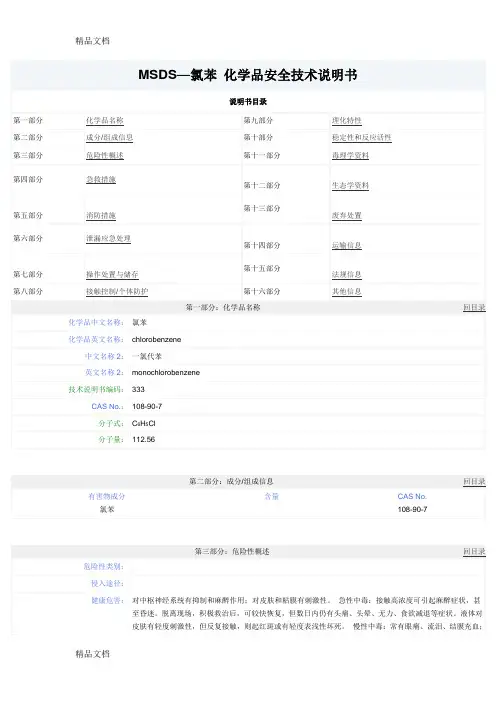
第二部分:成分/组成信息回目录有害物成分含量CAS No.
氯苯108-90-7
第六部分:泄漏应急处理回目录应急处理:迅速撤离泄漏污染区人员至安全区,并进行隔离,严格限制出入。
切断火源。
建议应急处理人员戴自给正压式呼吸器,穿防毒服。
尽可能切断泄漏源。
防止流入下水道、排洪沟等限制性空间。
小量泄漏:用砂土或其
它不燃材料吸附或吸收。
也可以用不燃性分散剂制成的乳液刷洗,洗液稀释后放入废水系统。
大量泄漏:构
筑围堤或挖坑收容。
用泡沫覆盖,降低蒸气灾害。
用防爆泵转移至槽车或专用收集器内,回收或运至废物处
理场所处置。
第十五部分:法规信息回目录法规信息化学危险物品安全管理条例(1987年2月17日国务院发布),化学危险物品安全管理条例实施细则(化劳发[1992] 677号),工作场所安全使用化学品规定([1996]劳部发423号)等法规,针对化学危险品的安全使用、生产、储存、运输、装卸等方面均作了相应规定;常用危险化学品的分类及标志(GB 13690-92)将该物质划为第3.3 类高闪点易燃液体。
其它法规:氯化苯生产安全技术规定(HGA008-83)。
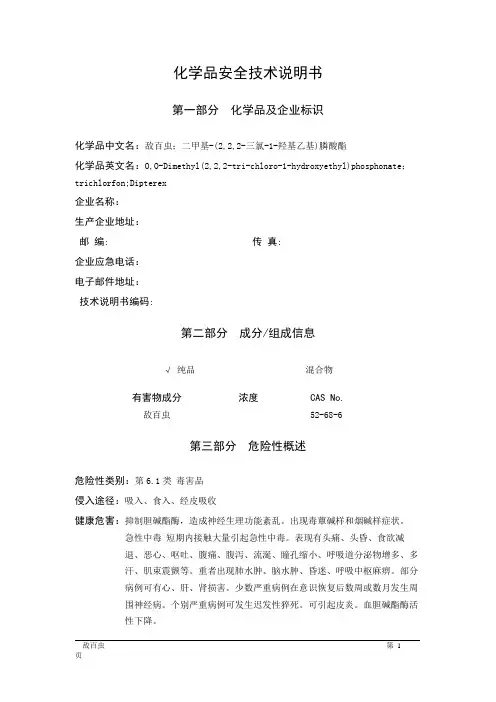
化学品安全技术说明书第一部分化学品及企业标识化学品中文名:敌百虫;二甲基-(2,2,2-三氯-1-羟基乙基)膦酸酯化学品英文名:O,O-Dimethyl(2,2,2-tri-chloro-1-hydroxyethyl)phosphonate;trichlorfon;Dipterex企业名称:生产企业地址:邮编: 传真:企业应急电话:电子邮件地址:技术说明书编码:第二部分成分/组成信息√纯品混合物有害物成分浓度CAS No.敌百虫52-68-6第三部分危险性概述危险性类别:第6.1类毒害品侵入途径:吸入、食入、经皮吸收健康危害:抑制胆碱酯酶,造成神经生理功能紊乱。
出现毒蕈碱样和烟碱样症状。
急性中毒短期内接触大量引起急性中毒。
表现有头痛、头昏、食欲减退、恶心、呕吐、腹痛、腹泻、流涎、瞳孔缩小、呼吸道分泌物增多、多汗、肌束震颤等。
重者出现肺水肿、脑水肿、昏迷、呼吸中枢麻痹。
部分病例可有心、肝、肾损害。
少数严重病例在意识恢复后数周或数月发生周围神经病。
个别严重病例可发生迟发性猝死。
可引起皮炎。
血胆碱酯酶活性下降。
慢性中毒尚有争论。
有神经衰弱综合征、多汗、肌束震颤等。
血胆碱酯酶活性降低。
环境危害:对水生生物有毒作用。
燃爆危险:可燃,其粉体与空气混合,能形成爆炸性混合物。
第四部分急救措施皮肤接触:立即脱去污染的衣着,用大量流动清水冲洗。
如有不适感,就医。
眼睛接触:提起眼睑,用流动清水或生理盐水冲洗。
如有不适感,就医。
吸入:迅速脱离现场至空气新鲜处。
保持呼吸道通畅。
如呼吸困难,给输氧。
呼吸、心跳停止,立即进行心肺复苏术。
就医。
食入:饮足量温水,催吐。
用1:5000高锰酸钾溶液洗胃。
口服活性碳,导泻。
每5分钟给服一片阿托品,直到感觉口干为止。
就医。
第五部分消防措施危险特性:遇明火、高热可燃。
受热分解,放出氧化磷和氯化物的毒性气体。
与强氧化剂接触可发生化学反应。
有害燃烧产物:一氧化碳、氯化氢、氧化磷。
灭火方法:用抗溶性泡沫、干粉、砂土灭火。
化学品安全技术说明书第一部分化学品及企业标识化学品中文名:灭蚜硫磷;O,O-二甲基-S-〔(4,6-二氨基-1,3,5-三嗪-2-甲基)〕二硫代磷酸酯;灭蚜灵;灭那虫;拌种剂;S-[(4,6-二氨基-1,3,5-三嗪-2-基)甲基]-O,O-二甲基二硫代磷酸酯化学品英文名:menazon;azidithion;S-4,6-diamino-1,3,5-triazin-2-ylmethyl O,O-dimethyl phosphorodithioate企业名称:生产企业地址:邮编: 传真:企业应急电话:电子邮件地址:技术说明书编码:第二部分成分/组成信息√纯品混合物有害物成分浓度CAS No.灭蚜松78-57-9第三部分危险性概述危险性类别:第6.1类毒害品侵入途径:吸入、食入、经皮吸收健康危害:能抑制胆碱酯酶活性,中毒后全血胆碱酶活性下降,中毒症状有头痛、头晕、恶心、呕吐、流涎、大汗、瞳孔缩小、肌肉震颤等,严重中毒出现肺水肿、脑水肿等。
急性中毒潜伏期约几天,胆碱酯酶抑制作用逐渐增强。
环境危害:对环境有害。
燃爆危险:可燃,其粉体与空气混合,能形成爆炸性混合物。
第四部分急救措施皮肤接触:立即脱去污染的衣着,用肥皂水及流动清水彻底冲洗污染的皮肤、头发、指甲等。
如有不适感,就医。
眼睛接触:提起眼睑,用流动清水或生理盐水冲洗。
如有不适感,就医。
吸入:迅速脱离现场至空气新鲜处。
保持呼吸道通畅。
如呼吸困难,给输氧。
呼吸、心跳停止,立即进行心肺复苏术。
就医。
食入:饮足量温水,催吐。
用1:5000高锰酸钾溶液洗胃。
口服活性碳,导泻。
每5分钟给服一片阿托品,直到感觉口干为止。
就医。
第五部分消防措施危险特性:遇明火、高热可燃。
其粉体与空气可形成爆炸性混合物, 当达到一定浓度时, 遇火星会发生爆炸。
受高热分解放出有毒的气体。
有害燃烧产物:一氧化碳、氮氧化物、氧化硫、氧化磷。
灭火方法:用雾状水、泡沫、干粉、二氧化碳、砂土灭火。
第一部分化学品及企业标识化学品中文名:杀螨好化学品英文名:TetrasulCAS No.:2227-13-6分子式:C12H6Cl4S产品推荐及限制用途:工业及科研用途。
第二部分危险性概述紧急情况概述皮肤接触有害。
对水生生物有害并具有长期持续影响。
GHS危险性类别急性经皮肤毒性类别 4危害水生环境——长期危险类别 3标签要素:象形图:警示词:警告危险性说明:H312 皮肤接触有害H412 对水生生物有害并具有长期持续影响防范说明●预防措施:—— P280 戴防护手套/穿防护服/戴防护眼罩/戴防护面具。
—— P273 避免释放到环境中。
●事故响应:—— P303+P361+P353 如皮肤(或头发)沾染:立即脱掉所有沾染的衣服。
用水清洗皮肤/淋浴。
—— P370+P378 火灾时:使用灭火器灭火。
—— P302+P352 如皮肤沾染:用水充分清洗。
—— P332+P313 如发生皮肤刺激:求医/就诊。
—— P362+P364 脱掉沾染的衣服,清洗后方可重新使用——P305+P351+P338 如进入眼睛:用水小心冲洗几分钟。
如戴隐形眼镜并可方便地取出,取出隐形眼镜。
继续冲洗。
—— P337+P313 如仍觉眼刺激:求医/就诊。
—— P304+P340 如误吸入:将人转移到空气新鲜处,保持呼吸舒适体位。
—— P312 如感觉不适,呼叫解毒中心/医生●安全储存:—— P403+P233 存放在通风良好的地方。
保持容器密闭。
—— P405 存放处须加锁。
●废弃处置:—— P501 按当地法规处置内装物/容器。
物理和化学危险:无资料。
健康危害:皮肤接触有害。
环境危害:对水生生物有害并具有长期持续影响。
第三部分成分/组成信息√物质混合物第四部分急救措施急救:吸入:如果吸入,请将患者移到新鲜空气处。
皮肤接触:脱去污染的衣着,用肥皂水和清水彻底冲洗皮肤。
如有不适感,就医。
眼晴接触:分开眼睑,用流动清水或生理盐水冲洗。
化学品安全技术说明书第一部分化学品及企业标识化学品中文名:消螨通;2-仲丁基-4,6-二硝基苯基异丙基碳酸酯;敌螨通化学品英文名:dinobuton;2-sec-butyl-4,6-dinitrophenyl isopropyl carbonate 企业名称:生产企业地址:邮编: 传真:企业应急电话:电子邮件地址:技术说明书编码:第二部分成分/组成信息√纯品混合物有害物成分浓度CAS No.消螨通937-21-7第三部分危险性概述危险性类别:第6.1类毒害品侵入途径:吸入、食入、经皮吸收健康危害:本品为中等毒杀虫剂。
对眼睛有轻度刺激作用。
吸入、摄入或经皮肤吸收后会中毒。
受热分解释出氮氧化物。
环境危害:对环境有害。
燃爆危险:可燃,其粉体与空气混合,能形成爆炸性混合物。
第四部分急救措施皮肤接触:立即脱去污染的衣着,用大量流动清水冲洗。
如有不适感,就医。
眼睛接触:提起眼睑,用流动清水或生理盐水冲洗。
如有不适感,就医。
吸入:迅速脱离现场至空气新鲜处。
保持呼吸道通畅。
如呼吸困难,给输氧。
呼吸、心跳停止,立即进行心肺复苏术。
就医。
食入:饮足量温水,催吐。
2%碳酸氢钠洗胃,硫酸镁导泻。
就医。
第五部分消防措施危险特性:遇明火、高热可燃。
其粉体与空气可形成爆炸性混合物, 当达到一定浓度时, 遇火星会发生爆炸。
受高热分解放出有毒的气体。
有害燃烧产物:一氧化碳、氮氧化物。
灭火方法:用雾状水、泡沫、干粉、二氧化碳、砂土灭火。
灭火注意事项及措施:消防人员须佩戴防毒面具、穿全身消防服,在上风向灭火。
尽可能将容器从火场移至空旷处。
喷水保持火场容器冷却,直至灭火结束。
第六部分泄漏应急处理应急行动:隔离泄漏污染区,限制出入。
消除所有点火源。
建议应急处理人员戴防尘口罩,穿防毒服。
穿上适当的防护服前严禁接触破裂的容器和泄漏物。
尽可能切断泄漏源。
用塑料布覆盖泄漏物,减少飞散。
勿使水进入包装容器内。
用洁净的铲子收集泄漏物,置于干净、干燥、盖子较松的容器中,将容器移离泄漏区。
化学品安全技术说明书第一部分化学品及企业标识化学品中文名:异硫氰酸苯酯;苯基芥子油化学品英文名:phenyl isothiocyanate;phenyl mustard oil企业名称:生产企业地址:邮编: 传真:企业应急电话:电子邮件地址:技术说明书编码:第二部分成分/组成信息√纯品混合物有害物成分浓度CAS No.异硫氰酸苯酯103-72-0第三部分危险性概述危险性类别:第6.1类毒害品侵入途径:吸入、食入健康危害:吸入本品对呼吸道有强烈刺激作用,可引起死亡。
对眼和皮肤有强烈刺激性,可引起灼伤。
慢性影响肝、肾损害。
环境危害:对环境有害。
燃爆危险:可燃,其蒸气与空气混合,能形成爆炸性混合物。
第四部分急救措施皮肤接触:立即脱去污染的衣着,用大量流动清水冲洗20~30分钟。
如有不适感,就医。
眼睛接触:立即提起眼睑,用大量流动清水或生理盐水彻底冲洗10~15分钟。
如有不适感,就医。
吸入:迅速脱离现场至空气新鲜处。
保持呼吸道通畅。
如呼吸困难,给输氧。
呼吸、心跳停止,立即进行心肺复苏术。
就医。
食入:用水漱口,给饮牛奶或蛋清。
就医。
第五部分消防措施危险特性:接触酸及酸气时,能放出有毒的氰化物及氧化硫烟气。
与强氧化剂接触可发生化学反应。
若遇高热可发生剧烈分解,引起容器破裂或爆炸事故。
有害燃烧产物:一氧化碳、氮氧化物、氧化硫。
灭火方法:采用泡沫、干粉、二氧化碳、砂土灭火。
灭火注意事项及措施:消防人员必须佩戴空气呼吸器、穿全身防火防毒服,在上风向灭火。
尽可能将容器从火场移至空旷处。
处在火场中的容器若已变色或从安全泄压装置中产生声音,必须马上撤离。
禁止使用酸碱灭火剂。
用水灭火无效,但可用水保持火场中容器冷却。
第六部分泄漏应急处理应急行动:根据液体流动和蒸气扩散的影响区域划定警戒区,无关人员从侧风、上风向撤离至安全区。
消除所有点火源。
建议应急处理人员戴正压自给式呼吸器,穿防毒服。
穿上适当的防护服前严禁接触破裂的容器和泄漏物。